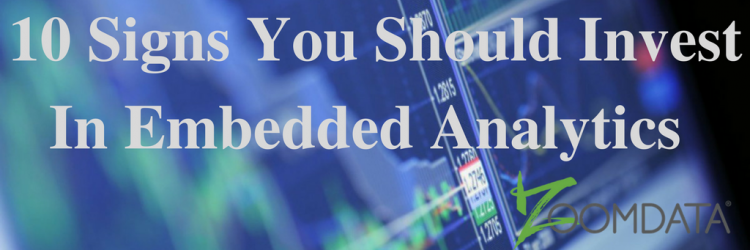Business intelligence and analytics have changed drastically over the years. We’ve come a long way from the slow and clunky green screen technologies of the 90’s and entered an age where it has become an inherent expectation to have information available immediately at our fingertips.
Powerful BI tools have emerged to fill the need for instant gratification with regards to business knowledge. More recently, embedded BI has emerged to fill the need to combine the instant availability of business intelligence with the flexibility to serve the information specifically where it is needed. Rather than existing within a rigid, stand-alone application that requires you to drop what you are doing to drill into the data, embedded BI can be customized and inserted into virtually any application in just the right context for the task at hand. Say goodbye to endlessly switching back and forth between applications and hello to business intelligence bliss.
Spreadsheets are great. They’re versatile, easily customizable, and come jam-packed with available charts, graphs, and other features. They’re also overused. Too often, we see spreadsheets being used as “databases” where numerous data tabs power the report tabs. Sometimes these spreadsheet-based reports work great on an ad-hoc basis, but for reports that need to be updated or presented in a context-specific format, they can become a burden.
Embedded BI drastically cuts down the time analysts will spend building and rebuilding reports and instead allow users to view what they need and where they need it.
You’re constantly struggling to merge information.
Many businesses spend an extraordinary amount of time cleaning and prepping data. It is likely that you’ve been involved in a project that revolved around collecting data from separate applications within the company and combining it into a spreadsheet in hopes that nothing was lost in translation. Embedded BI allows us to blend information from any number of disparate data sources without moving the data back and forth between different systems.
You’re considering hiring a developer to create a custom application.
Sometimes, the needs of a business are so unique that they require custom applications be built to satisfy those needs. Other times, those needs are only perceived to be unique because existing applications are missing that last piece of functionality that would let us deem them as perfect. In these cases, one of the greatest embedded BI benefits is the ability to include that last chunk of information as an embedded visualization within the application.
Rather than investing in an expensive developer, we can improve upon existing applications through embedded BI.
You thought custom analytics were for the large companies.
Even today, many larger companies with deep pockets throw money into custom applications to satisfy their BI needs. However, with embedded BI, we can customize our existing applications to provide context-specific reports and visualizations.
Even better, modern visual analytics providers often give us an intuitive interface to create them, eliminating the need for expensive developers to be involved in the first place while also drastically cutting down on time to market.
Your business is consumer-facing.
In today’s digital world, it is harder than ever to capture the attention of the consumer, particularly when everyone else is clamoring to do so as well. However, we can include consumer demographics data in our embedded BI applications to gain a better understanding of the customer within any variety of contexts.
Embedded applications put the information at our fingertips, making important information about consumer customers more readily available than ever before.
Your business is business-facing.
Just like with consumer data, there is a ton of data and information that can be blended into embedded BI, such as industry trends and information specific to the customer or customer segment.
B2B is often just as competitive as selling to consumers. It is important to keep a competitive advantage by knowing as much as possible about B2B customers.
The competition seems to be one step ahead.
Perhaps the two main reasons for business intelligence in the first place are the ability to better understand your customers and the ability to outthink your competition. With the ever-increasing amount of data and number of data sources we have to work with, it has become more and more difficult to stay on top of the trends and insights that lie within.
Using embedded BI, we can more easily create actionable visualizations within business applications that allow us to keep that competitive advantage.
As you can see, embedded BI offers an array of benefits. The ability to embed visualizations and reports into other applications will save time and money while providing for insights and competitive advantages to propel the business into the future. Discover some additional embedded BI benefits here: https://www.zoomdata.com/resource/embedded-analytics-video/
